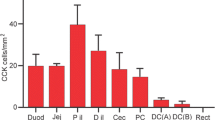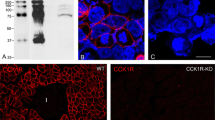Abstract
ECL cells in the oxyntic mucosa of the mouse and rat stomach express CCK2 receptors, which enable them to respond to gastrin by the production and release of histamine. We have studied CCK2 receptor-deficient mice and rats subjected to pharmacological CCK2 receptor blockade in an attempt to demonstrate the importance of gastrin signaling for ECL-cell differentiation and proliferation. In CCK2 receptor knockout mice, the ECL cells were replaced by a novel endocrine-like cell type lacking histamine and histidine decarboxylase but retaining pancreastatin and vesicle monoamine transporter type 2 (VMAT2). Ultrastructurally, they were characterized by the presence of small dense-core granules and microvesicles and by the absence of the secretory vesicles that are a hallmark feature of wild-type ECL cells. Upon pharmacological CCK2 receptor blockade, the ECL cells became small and inactive, although unchanged in number. By immunocytochemistry (histamine, pancreastatin and VMAT2) and electron microscopy (secretory vesicles) they remained recognizable as ECL cells; their proliferation in response to hypergastrinemia was prevented.
Similar content being viewed by others
REFERENCES
Bakke, I., Qvigstad, G., Sandvik, A. K., et al. (2001). The CCK-2 receptor is located on the ECL cell, but not on the parietal cell, Scand. J. Gastroenterol. 36, 1128–1133.
Böttcher, G., Håkanson, R., Nilsson, G., et al. (1989). Effects of long-termhypergastrinaemia on the ultrastructure of enterochromaffin-like cells in the stomach of the rat, hamster and guinea pig, Cell Tissue Res. 256, 247–257.
Canese, M. G. and Bussolati, G. (1977). Immuno-electron-cytochemical localization of the somatostatin cells in the human antral mucosa, J. Histochem. Cytochem. 25, 1111–1118.
Chen, D., Nylander, A. G., Rehfeld, J. F., et al. (1993). Hypercholecystokininemia produced by pancreaticobiliary diversion causes gastrin-like effects on enterochromaffin-like cells in the stomach of rats subjected to portacaval shunting or antrectomy, Scand. J. Gastroenterol. 28, 988–992.
Chen, D., Monstein, H. J., Nylander, A. G., et al. (1994). Acute responses of rat stomach enterochromaffinlike cells to gastrin: secretory activation and adaptation, Gastroenterology 107, 18–27.
Chen, D., Zhao, C. M., Andersson, K., et al. (1996a). Ultrastructure of enterochromaffi n-like cells in rat stomach: effects of alpha-fluoromethylhistidine-evoked histamine depletion and hypergastrinemia, Cell Tissue Res. 283, 469–478.
Chen, D., Zhao, C. M., Nylander, A. G., et al. (1996b). Time course of hypertrophic and ultrastructural responses of rat stomach enterochromaffin-like cells to sustained hypergastrinemia, Cell Tissue Res. 284, 55–63.
Chen, D., Zhao, C. M., Lindström, E., et al. (1999). Rat stomach ECL cells up-date of biology and physiology, Gen. Pharmacol. 32, 413–422.
Chen, D., Zhao, C. M., Norlén, P., et al. (2000). Effect of cholecystokinin-2 receptor blockade on rat stomach ECL cells. A histochemical, electron-microscopic and chemical study, Cell Tissue Res. 299, 81–95.
Chen, D., Zhao, C. M., Al-Haider, W., et al. (2002). Differentiation of gastric ECL cells is altered in CCK2 receptor-deficient mice, Gastroenterology 123, 577–585.
Dartsch, C. and Persson, L. (1998). Recombinant expressionof rat histidinedecarboxylase: generation of antibodies useful for western blot analysis, Int. J. Biochem. Cell Biol. 30, 773–782.
Dartsch, C., Sundler, F. and Persson, L. (1999). Antisera against rat recombinant histidine decarboxy-lase: immunocytochemical studies in different species, Histochem. J. 31, 507–514.
De Giorgio, R., Su, D., Peter, D., et al. (1996). Vesicular monoamine transporter 2 expression in enteric neurons and enterochromaffin-like cells of the rat, Neurosci. Lett. 217, 77–80.
Dornonville de la Cour, C., Björkqvist, M., Sandvik, A. K., et al. (2001). A-like cells in the rat stomach contain ghrelin and do not operate under gastrin control, Regul. Pept. 99, 141–150.
Facer, P., Bishop, A. E., Lloyd, R. V., et al. (1985). Chromogranin: a newly recognized marker for endocrine cells of the human gastrointestinal tract, Gastroenterology 89, 1366–1373.
Friis-Hansen, L., Sundler, F., Li, Y., et al. (1998). Impaired gastric acid secretion in gastrin-defi cient mice, Am. J. Physiol. 274, G561–G568.
Håkanson, R. and Owman, C. (1969). Argyrophilic reaction of histamine-containing epithelial cells in murine gastric mucosa, Experientia 25, 625–626.
Håkanson, R. and Sundler, F. (1990). Proposed mechanism of induction of gastric carcinoids: the gastrin hypothesis, Eur. J. Clin. Invest. 20 (Suppl. 1), S65–S71.
Håkanson, R. and Sundler, F. (1991). Histamine-producing cells in the stomach and their role in the regulation of acid secretion, Scand. J. Gastroenterol. Suppl. 180, 88–94.
Håkanson, R., Böttcher, G., Ekblad, E., et al. (1986). Histamine in endocrine cells in the stomach. A survey of several species using a panel of histamine antibodies, Histochemistry 86, 5–17.
Håkanson, R., Tielemans, Y., Chen, D., et al. (1993). Time-dependent changes in enterochromaffin-like cell kinetics in stomach of hypergastrinemic rats, Gastroenterology 105, 15–21.
Håkanson, R., Chen, D. and Sundler, F. (1994). The ECL cells, in: Physiology of the Gastrointestinal Tract, L. R. Johnson (Ed.), Vol. 2, 3rd edn, pp. 1171–1184. Raven Press.
Havu, N. (1986). Enterochromaffin-like cell carcinoids of gastric mucosa in rats after life-long inhibition of gastric secretion, Digestion 35 (Suppl. 1), 42–55.
Havu, N., Mattsson, H., Ekman, L., et al. (1990). Enterochromaffi n-like cell carcinoids in the rat gastric mucosa following long-term administration of ranitidine, Digestion 45, 189–195.
Helander, H. F., Wong, H., Poorkhalkali, N., et al. (1997). Immunohistochemical localization of gastrin/CCK-B receptors in the dog and guinea-pig stomach, Acta Physiol. Scand. 159, 313–320.
Hohne-Zell, B., Galler, A., Schepp, W., et al. (1997). Functional importance of synaptobrevin and SNAP-25 during exocytosis of histamine by rat gastric enterochromaffin-like cells, Endocrinology 138, 5518–5526.
Kidd, M., Modlin, I. M. and Tang, L. H. (1998). Gastrin and the enterochromaffin-like cell: an acid update, Dig. Surg. 15, 209–217.
Kubota, H., Hayashi, H., Watanabe, T., et al. (1984). Mechanism of inactivation of mammalian L-histidine decarboxylase by (S)-alpha-fluoromethylhistidine, Biochem. Pharmacol. 33, 983–990.
Langhans, N., Rindi, G., Chiu, M., et al. (1997). Abnormal gastric histology and decreased acid production in cholecystokinin-B/ gastrin receptor-defi cient mice, Gastroenterology 112, 280–286.
Lindström, E., Björkqvist, M., Boketoft, A., et al. (1997). Neurohormonal regulation of histamine and pancreastatin secretion from isolated rat stomach ECL cells, Regul. Pept. 71, 73–86.
Lindström, E., Björkqvist, M. and Håkanson, R. (1999). Pharmacological analysis of CCK2 receptor antagonists using isolated rat stomach ECL cells, Br. J. Pharmacol. 127, 530–536.
Lindström, E., Chen, D., Norlén, P., et al. (2001). Control of gastric acid secretion: the gastrin-ECL cell-parietal cell axis, Comp. Biochem. Physiol. A: Mol. Integr. Physiol. 128, 505–514.
Nagata, A., Ito, M., Iwata, N., et al. (1996). G protein-coupled cholecystokinin-B/ gastrin receptors are responsible for physiological cell growth of the stomach mucosa in vivo, Proc. Natl. Acad. Sci. USA 93, 11825–11830.
Norlén, P., Curry, W. J., Björkqvist, M., et al. (2001). Cell-specific processing of chromogranin A in endocrine cells of the rat stomach, J. Histochem. Cytochem. 49, 9–18.
Nylander, A. G., Chen, D., Lilja, I., et al. (1993). Enterochromaffin-like cells in rat stomach respond to short-terminfusion of high doses of cholecystokinin but not to long-term, sustained, moderate hyperCCKemia caused by continuous cholecystokinin infusion or pancreaticobiliary diversion, Scand. J. Gastroenterol. 28, 73–79.
Pearse, A. G. and Bussolati, G. (1972). The identification of gastrin cells as G cells, Virchows Arch. A: Pathol. Pathol. Anat. 355, 99–104.
Prinz, C., Kajimura, M., Scott, D. R., et al. (1993). Histamine secretion from rat enterochromaffinlike cells, Gastroenterology 105, 449–461.
Rindi, G., Paolotti, D., Fiocca, R., et al. (2000). Vesicular monoamine transporter 2 as a marker of gastric enterochromaffin-like cell tumors, Virchows Arch. 436, 217–223.
Ryberg, B., Tielemans, Y., Axelson, J., et al. (1990). Gastrin stimulates the self-replication rate of enterochromaffinlike cells in the rat stomach. Effects of omeprazole, ranitidine, and gastrin-17 in intact and antrectomized rats, Gastroenterology 99, 935–942.
Solcia, E., Rindi, G., Buffa, R., et al. (2000). Gastric endocrine cells: types, function and growth, Regul. Pept. 93, 31–35.
Tielemans, Y., Willems, G., Sundler, F., et al. (1990a). Self-replication of enterochromaffin-like cells in the mouse stomach, Digestion 45, 138–146.
Tielemans, Y., Axelson, J., Sundler, F., et al. (1990). Serum gastrin concentration affects the self replication rate of the enterochromaffin-like cells in the rat stomach, Gut 31, 274–278.
Tielemans, Y., Chen, D., Sundler, F., et al. (1992). Reversibility of the cell kinetic changes induced by omeprazole in the rat oxyntic mucosa. An autoradiographicstudy using tritiated thymidine, Scand. J. Gastroenterol. 27, 155–160.
Wang, T. C., Dangler, C. A., Chen, D., et al. (2000). Synergistic interaction between hypergastrinemia and Helicobacter infection in a mouse model of gastric cancer, Gastroenterology 118, 36–47.
Waldum, H. L., Sandvik, A. K., Brenna, E., et al. (1991). Gastrin-histaminesequence in the regulation of gastric acid secretion, Gut 32, 698–701.
Zeng, N., Kang, T., Lyu, R. M., et al. (1998). The pituitary adenylate cyclase activating polypeptide type 1 receptor (PAC1-R) is expressed on gastric ECL cells: evidence by immunocytochemistry and RT-PCR, Ann. NY Acad. Sci. 865, 147–156.
Zhao, C. M., Jacobsson, G., Chen, D., et al. (1997). Exocytotic proteins in enterochromaffin-like (ECL) cells of the rat stomach, Cell Tissue Res. 290, 539–551.
Zhao, C. M., Chen, D., Andersson, K., et al. (1998). ECL cells of the rat stomach: development of lipofuscin in response to sustained gastrin stimulation, Cell Tissue Res. 291, 315–323.
Zhao, C. M., Chen, D., Lintunen, M., et al. (1999a). Effects of reserpine on ECL-cell ultrastructure and histamine compartmentalizationin the rat stomach, Cell Tissue Res. 295, 131–140.
Zhao, C. M., Chen, D., Lintunen, M., et al. (1999b). Secretory organelles in ECL cells of the rat stomach: an immunohistochemical and electron-microscopic study, Cell Tissue Res. 298, 457–470.
Zhao, C. M., Bakke, I., Tostrup-Skogaker, N., et al. (2001). Functionally impaired, hypertrophic ECL cells accumulate vacuoles and lipofuscin bodies. An ultrastructural study of ECL cells isolated from hypergastrinemicrats, Cell Tissue Res. 303, 415–422.
Rights and permissions
About this article
Cite this article
Chen, D., Håkanson, R., Rehfeld, J.F. et al. CCK2 receptors are necessary for the differentiation and proliferation of ECL cells in mouse and rat stomach. Inflammopharmacology 10, 351–364 (2002). https://doi.org/10.1163/156856002321544828
Issue Date:
DOI: https://doi.org/10.1163/156856002321544828




